

The Big Five Personality Test. Directions: The following statements concern your perception about yourself in a variety of situations.
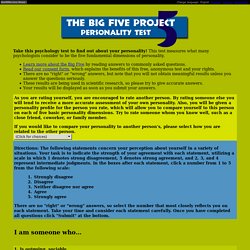
Your task is to indicate the strength of your agreement with each statement, utilizing a scale in which 1 denotes strong disagreement, 5 denotes strong agreement, and 2, 3, and 4 represent intermediate judgments. In the boxes after each statement, click a number from 1 to 5 from the following scale: Strongly disagreeDisagreeNeither disagree nor agreeAgreeStrongly agree There are no "right" or "wrong" answers, so select the number that most closely reflects you on each statement.
List of emotions. The contrasting and categorisation of emotions describes how emotions are thought to relate to each other.
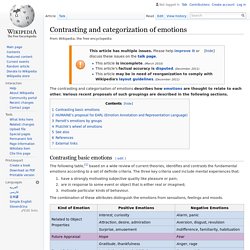
Various recent proposals of such groupings are described in the following sections. Contrasting basic emotions[edit] Trends Watch. Chart of Enneagram Types. Expanding the Science and Practice of Gratitude. For too long, we’ve taken gratitude for granted.

Yes, “thank you” is an essential, everyday part of family dinners, trips to the store, business deals, and political negotiations. That might be why so many people have dismissed gratitude as simple, obvious, and unworthy of serious attention. But that’s starting to change. MARSEILLE. Personality Assesments. Art SELL. Psychology. Psychology references. Anatomy of the brain. Cognitive Psychology. Cognitive Science.
Mindfulness. List of cognitive biases. Systematic patterns of deviation from norm or rationality in judgment Cognitive biases are systematic patterns of deviation from norm and/or rationality in judgment. They are often studied in psychology, sociology and behavioral economics.[1] Psychology studies relevant to everyday life from PsyBlog. The Art of Complex Problem Solving. Personality Types. Personality Tests.
The Right Mix of Personality Types: 5 Lessons From the Animal Kingdom. Personality/Psychology. Enneagram tests, type descriptions, forums. The Top 10 Psychology Studies of 2010. The end of 2010 fast approaches, and I'm thrilled to have been asked by the editors of Psychology Today to write about the Top 10 psychology studies of the year. I've focused on studies that I personally feel stand out, not only as examples of great science, but even more importantly, as examples of how the science of psychology can improve our lives. Each study has a clear "take home" message, offering the reader an insight or a simple strategy they can use to reach their goals , strengthen their relationships, make better decisions, or become happier.
If you extract the wisdom from these ten studies and apply them in your own life, 2011 just might be a very good year. 1) How to Break Bad Habits If you are trying to stop smoking , swearing, or chewing your nails, you have probably tried the strategy of distracting yourself - taking your mind off whatever it is you are trying not to do - to break the habit. J. 2) How to Make Everything Seem Easier J. The Big Five Personality Test. Personality Quiz Site - tests and quizzes. Table of similar systems of comparison of temperaments. Beginnings[edit] The Roman physician Galen mapped the four temperaments (sanguine, phlegmatic, choleric and melancholic) to a matrix of hot/cold and dry/wet, taken from the four classical elements.[1] Two of these temperaments, sanguine and choleric, shared a common trait: quickness of response (corresponding to "heat"), while the melancholic and phlegmatic shared the opposite, a longer response (coldness).

Psychology/Personality. Personality Traits List. Personality Traits List In the field of psychology, there are five main dimensions of a personality that is used to describe a personality type.

These five main dimensions are known as the Big Five factors or Five Factor Model. These main dimensions have been arrived at by empirical, data driven research. Though the initial model was proposed and advanced by Raymon Cristal and Ernest Tupes in 1961, it was only in 1990s that the refined five factor model was advanced by J M Digman. These five main domains cover most of the personality traits and are assumed to represent the basic structure behind all personality types.
Openness: This is characterized by general appreciation for adventure, art, imagination, curiosity, unusual ideas and a variety of experiences. Conscientiousness: Individuals who display this trait are dutiful, self disciplined and they aim for achievement. Tags: personality traits list. Links to hundreds of Psychology studies running on the internet. 'Mind reading' brain scans reveal secrets of human vision. Courtesy of Fei-Fei Li Researchers were able to determine that study participants were looking at this street scene even when the participants were only looking at the outline.

Researchers call it mind reading. One at a time, they show a volunteer – who's resting in an MRI scanner – a series of photos of beaches, city streets, forests, highways, mountains and offices. Why genius and madness are connected. Many of history's most celebrated creative geniuses were mentally ill, from renowned artists Vincent van Gogh and Frida Kahlo to literary giants Virginia Woolf and Edgar Allan Poe.
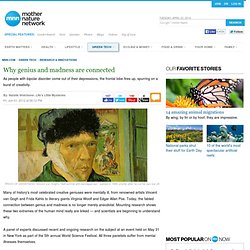
Today, the fabled connection between genius and madness is no longer merely anecdotal. Mounting research shows these two extremes of the human mind really are linked — and scientists are beginning to understand why. A panel of experts discussed recent and ongoing research on the subject at an event held on May 31 in New York as part of the 5th annual World Science Festival. All three panelists suffer from mental illnesses themselves.
Kay Redfield Jamison, a clinical psychologist and professor at Johns Hopkins University School of Medicine, said the findings of some 20 or 30 scientific studies endorse the notion of the "tortured genius. " Bipolar disorder entails dramatic mood swings between extreme happiness (known as "mania") and severe depression. Personality types. MSNBC - How to Think About the Mind. How to Think About the MindNeuroscience shows that the 'soul' is the activity of the brain Sept. 27 issue - Every evening our eyes tell us that the sun sets, while we know that, in fact, the Earth is turning us away from it.
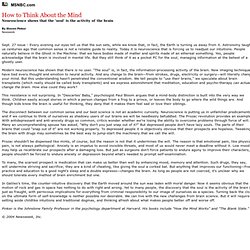
Astronomy taught us centuries ago that common sense is not a reliable guide to reality. Today it is neuroscience that is forcing us to readjust our intuitions. People naturally believe in the Ghost in the Machine: that we have bodies made of matter and spirits made of an ethereal something. Yes, people acknowledge that the brain is involved in mental life. Modern neuroscience has shown that there is no user. This resistance is not surprising. Creative Thought Processes. How the Mind Works.
Intelligence Forms. This is (not) psychology. Character & structures. Psychology. Psychology Studies. Dan Gilbert: Why we make bad decisions. Dan Pink: The surprising science of motivation. 20 Things I Should Have Known at 20. Color Psychology. By David Johnson Like death and taxes, there is no escaping color.

It is ubiquitous. Yet what does it all mean? Why are people more relaxed in green rooms? Why do weightlifters do their best in blue gyms? Colors often have different meanings in various cultures. Black Black is the color of authority and power. White Brides wear white to symbolize innocence and purity. Red The most emotionally intense color, red stimulates a faster heartbeat and breathing. The most romantic color, pink, is more tranquilizing. Blue. Music Psychology. Innovation, creativity and brainstorming resources from Innovati.
Assistive technology. Psychological. FUTURE PSYCHOLOGICAL EVOLUTION. DynaPsych Table of Contents Future Psychological Evolution John Stewart.
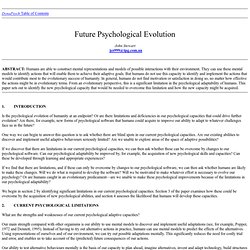
Positive psychology. Scientists discover previously unknown cleaning system in brain. A previously unrecognized system that drains waste from the brain at a rapid clip has been discovered by neuroscientists at the University of Rochester Medical Center. The findings were published online August 15 in Science Translational Medicine. The highly organized system acts like a series of pipes that piggyback on the brain's blood vessels, sort of a shadow plumbing system that seems to serve much the same function in the brain as the lymph system does in the rest of the body – to drain away waste products.
"Waste clearance is of central importance to every organ, and there have been long-standing questions about how the brain gets rid of its waste," said Maiken Nedergaard, M.D., D.M.Sc., senior author of the paper and co-director of the University's Center for Translational Neuromedicine. "This work shows that the brain is cleansing itself in a more organized way and on a much larger scale than has been realized previously. "It's a hydraulic system," said Nedergaard.
Neural balls and strikes: Where categories live in the brain. Public release date: 15-Jan-2012 [ Print | E-mail Share ] [ Close Window ] Contact: Robert Mitchumrobert.mitchum@uchospitals.edu 773-484-9890University of Chicago Medical Center Hundreds of times during a baseball game, the home plate umpire must instantaneously categorize a fast-moving pitch as a ball or a strike. In new research from the University of Chicago, scientists have pinpointed an area in the brain where these kinds of visual categories are encoded. While monkeys played a computer game in which they had to quickly determine the category of a moving visual stimulus, neural recordings revealed brain activity that encoded those categories.
6 Insane Things Science Can Predict About You at Infancy. #3. Smaller Babies Do Worse on Exams Getty Want to know whether it's worth it to put money aside for your baby's college education? The Eight Basic Scripts. How walking through a doorway increases forgetting. PsyArt: An Online Journal for the Psychological Study of the Arts. Neurology. The Whole Brain Atlas. Helen Fisher: The brain in love. Brain Atlas - Introduction. Brain from top to bottom. Critical Thinking. How to Trick Your Brain for Happiness.
This month, we feature videos of a Greater Good presentation by Rick Hanson, the best-selling author and trailblazing psychologist. In this excerpt from his talk, Dr. Controlling Computers with Your Mind - NIH Research Matters. November 8, 2010.